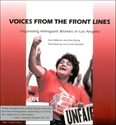Voices from the Front Lines: Organizing Immigrant Workers in Los Angeles
Ruth Milkman and Kent Wong, Translated by Luis Escala Rabadan
January 1, 2000
Economic Justice, Immigration, Publications, Working Class History, Book/Edited VolumeSummary
After many years of decline and demoralization, the labor movement in the United States is growing. A new, energetic leadership is at the helm of the AFL-CIO. And most important, unions are organizing workers again, on a scale the United States has not seen for many decades. Los Angeles, despite its history earlier in the twentieth century as a bastion of anti-unionism, has emerged as a focal point for the new American labor movement. Some of the past decade's most impressive union organizing victories have occurred here. Even more surprising, these successful organizing campaigns have involved immigrants, many of them undocumented--a group of workers generally viewed as unlikely recruits to labor unions.
Today, immigrants are a major presence all over the United States, but the greatest concentration of foreign-born workers is in Southern California. Fully one-third of the labor force in greater Los Angeles is made up of immigrants (compared to about 10 percent nationwide). Southern California boasts one of the most diverse workforces in the world, including the nation's largest Latino and Asian populations. Latinos are the largest immigrant group in the region, most of them born in Mexico and Central America. They are particularly concentrated in low-wage, relatively unskilled manual jobs--the sorts of jobs that have traditionally been the prime recruiting ground for labor unions. Indeed the vast majority of blue collar workers in Los Angeles's factories, construction sites, hotels, restaurants, hospitals, and other service industries today are Latino immigrants.
Most of these workers do not share in the prosperity projected in the glamorous image of Los Angeles as the nation's media and entertainment capital. In fact, levels of inequality in income and wealth here are among the most extreme in the nation. Over 40 percent of L.A. County residents live in households with annual incomes under $20,000. Many of them are the Latino immigrants who work in poverty wage jobs all over the Southland's diverse economy. Most are paid very little for their daily efforts, receive few if any fringe benefits, and only 11 percent are unionized (less than half the level of unionization among native-born workers in the area). However, thanks to the efforts of talented organizers such as the five individuals whose voices are represented in this book, that began to change in the 1990s. They are all at the forefront of immigrant union organizing in Los Angeles, and their work has opened an exciting new chapter in the nation's labor history.
The United States is a nation of immigrants, and earlier in this century the labor movement's growth was based on extensive recruitment of foreign-born workers and their offspring. In the years since World War II, however, immigrants have not always been welcome in the House of Labor, either in Los Angeles or in the nation as a whole. In fact, many union leaders took the position that immigrant workers should not be allowed to enter the country, fearing that they would lower wages, undermine existing unions, or be used as strikebreakers. The leaders of the Los Angeles labor movement, most of them native-born men, were particularly hostile to undocumented immigrants until recently. The conventional wisdom was that such workers were virtually impossible to organize because of their fear of deportation and their apparent acceptance of wages that were low by U.S. standards but far higher than in their home countries. In the 1990s, however, that conventional wisdom was proven wrong, as this book documents in detail. When unions do reach out to immigrant workers, they are often extremely receptive.
This book presents the experiences and reflections of five key figures in the Los Angeles labor movement who represent the new face of unionism in California:
- Cristina Vazquez of the Union of Needletrades, Industrial and Textile Employees
- Maria Elena Durazo of the Hotel Employees and Restaurant Employees, Local 11
- Rocio Saenz, of the Service Employees International Union's "Justice for Janitors" campaign
- Macario Camorlinga, a strike leader and International Association of Machinists organizer
- Jesus Gomez, a leader of the 1992 drywallers strike and now on the Carpenters' union staff
Their names are not well known outside the labor movement, but all of them are modern pioneers. They have demonstrated the tremendous potential for organizing immigrant workers into the labor movement. If the labor movement's revitalization--and perhaps its very survival--depends on new organizing, including new immigrant organizing, labor activists throughout the country can learn a great deal from their stories.


